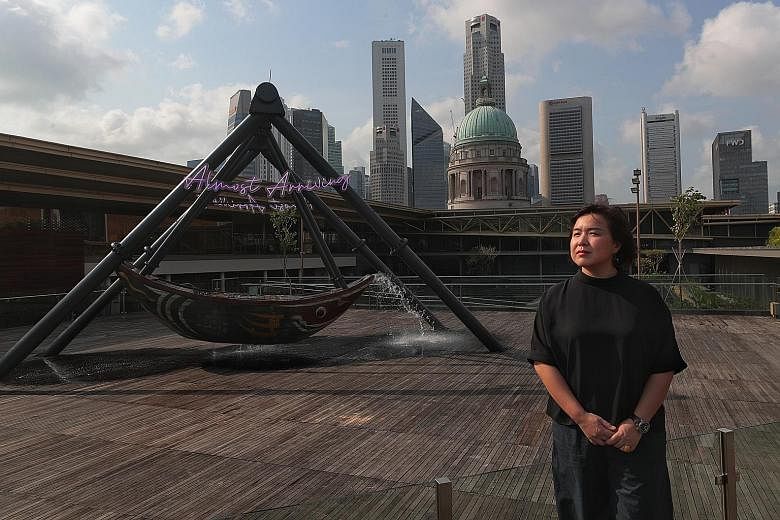A weathered swing boat has dropped anchor on the roof of the National Gallery Singapore.
Mysterious yet playful, it rocks back and forth as abstract soundscapes play in the background. Occasionally, the boat unleashes a wave of water.
The sampan-like vessel, which landed on the island's shores after a journey via cargo ship from Shanghai, where it was made, is the creation of Beijing-based artist Cao Fei. Cao, 42, a star in the contemporary art firmament, describes the work as an "affirmation of the possibilities of the future".
Fu Cha, as the 5m-tall work is known, alludes to Singapore's history as a port city and is painted with protective motifs - such as a pair of eyes to help the boat find its way back to land, and eels to plug leaks. It borrows its name from a raft in Chinese mythology that traverses the sea and Milky Way.
"It's an abstract idea, a longing for a kind of utopia," says Cao in Mandarin during a phone call on WeChat. "At the same time, it is a risky journey into the unknown. It connects past, present and future."
The Guangzhou-born artist's past projects include Whose Utopia? (2006), filmed in a light-bulb factory in China where she got workers to act out their dreams; RMB City: A Second Life City Planning (2007), looking at the pace of change in China through a virtual metropolis; and Asia One (2018), a speculative fiction film set in an automated sorting centre.
As she is best known for her multimedia and video works, she was "quite surprised" when the gallery invited her to create something for its Ng Teng Fong Roof Garden series, whose past commissions have ranged from a tearoom in a bamboo maze by United States-based Thai artist Rirkrit Tiravanija, to a project by Singapore artist Charles Lim, who gathered various plant species that thrived on land reclamation sites.
While Cao's outdoor sculpture - which opens to the public on Friday - has taken her into less familiar terrain, it seems she still had her film-maker's hat on while working on it. The boat's motions are a kind of performance and the rooftop deck like a stage, she says.
"I'm not just showing my audience a sculpture. It's temporal, it can move and it has different 'scenes' - such as moments when it spouts water and when it doesn't."
The public is invited to look at the installation by standing at different viewing points. For safety reasons, they are not allowed to touch the moving sculpture.
Ms Sam I-shan, who curated the project with her gallery colleague Cheng Jia Yun, says Fu Cha involved "a lot of complicated engineering".
-
VIEW IT /NG TENG FONG ROOF GARDEN COMMISSION: CAO FEI
-
WHERE: City Hall Wing, Level 5 Ng Teng Fong Roof Garden Gallery
WHEN: Friday to Oct 25; The boat will be in motion from 11am to 8pm
ADMISSION: Free
The water in the boat - Newater - splashes off and runs through the deck into a hidden catchment tray underneath before being piped back into the boat through the A-frame structure.
Cao is married to Singapore artist Lim Tzay Chuen. The couple have two children, aged 10 and eight.
"I feel Singapore tries to construct a kind of utopia," she says.
With a nod to landmarks such as the sprawling retail and tourist destination Jewel, she adds: "Even without stepping out of the airport, you are heavily stimulated by the country's entertainment, food and shopping attractions."
In March, she will launch a solo exhibition at London's Serpentine Gallery.
This will be followed by another solo show at Beijing's UCCA Centre for Contemporary Art - her first major solo show in China - from September onwards.
Cao, who has had solo shows in other venues such as New York's MoMA PS1 and Paris' Centre Pompidou, notes that women are still a minority in the art industry, but wonders how helpful it is to fixate on such categories.
"In Europe, you often see a lot of big prizes that are reserved specifically for women. On the one hand, this could be a powerful source of validation, but there are times when it becomes a bit too much - it places too much emphasis on the fact that they are women.
"Once you put people into boxes based on their gender or their territories, you don't talk about them in an equal context.
"But as artists move onto bigger international platforms, this could slowly change."


